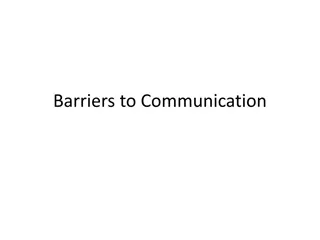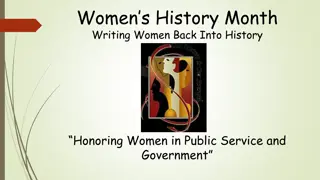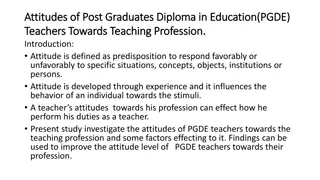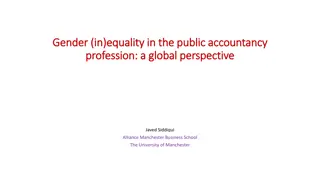Women Leaders in the Teaching Profession: Breaking Barriers and Inspiring Change
Leadership is about influencing and inspiring others towards common goals. Despite gender biases and societal challenges, women in the teaching profession are breaking barriers and making significant contributions as leaders. This article explores the gender issues, challenges faced, and benefits of having female leaders in education. It emphasizes the unique qualities and strengths that women bring to leadership roles, promoting collaboration, communication, and accountability for a positive impact on schools and communities.
Download Presentation

Please find below an Image/Link to download the presentation.
The content on the website is provided AS IS for your information and personal use only. It may not be sold, licensed, or shared on other websites without obtaining consent from the author.If you encounter any issues during the download, it is possible that the publisher has removed the file from their server.
You are allowed to download the files provided on this website for personal or commercial use, subject to the condition that they are used lawfully. All files are the property of their respective owners.
The content on the website is provided AS IS for your information and personal use only. It may not be sold, licensed, or shared on other websites without obtaining consent from the author.
E N D
Presentation Transcript
WOMEN LEADERS IN THE TEACHING PROFESSION THERE IS NO LIMIT TO WHAT WE AS WOMEN CAN ACCOMPLISH. MICHELLE OBAMA
1. What is leadership? Leadership is the ability to influence a group towards the achievement of goals. It is the process of providing direction, energizing others and obtaining their voluntary commitment to the leaders vision. A leader with a clear vision, is able to communicate their ideas in a way that connects with others, has a capacity to make difficult choices and make judgements that are in the best interest of an organization Leaders are risk takers who are open to new ideas, always learning and developing Leadership is not gender specific but leaders can be either men or women Leadership qualities are cultivated in person and can develop an individual into a great leader
2. GENDER ISSUES AND SCHOOL LEADERSHIP Problems affecting women and men that result from society s perceived generalization and beliefs on characteristics, capabilities, and behavior of men and women. These generalizations limit the understanding of what women and men can be and do Most teachers in the education profession are females, but school leadership positions are dominated by men at all levels Females are underrepresented in management positions especially in the senior management Unequal distribution of men and women in leadership positions is a reality Women themselves have internalized that they are not ready for leadership and management positions
3. Challenges/ Barriers faced by female school leaders - Culture is a symbolic communication in the form beliefs,traditions, ideas attitudes, morals and values. Cultural beliefs held by teachers and community members plays a huge role Glass Ceiling intangible existence that obstruct advancement of women just because they are women Traditional Stereotypes doubt and lack of trust. SMT will undermine, disrespect and challenge you , not cooperative. Emotional Taxing: issues of pull her down syndrome, patriarchy, imposter syndrome Insubordination by male subordinates resistance from male counterparts who also influence other female staff members to stand against the female principal Attitudes of parents and SGB members have no confidence in you, look down upon you Personal Challenges balancing work and their roles as mothers at home. Management position demands a round the clock work schedule
Benefits of Female Leaders in the Education In the twenty first century, qualities to lead include the ability to collaborate, communicate, accountability, flexibility, curiosity, persistence and resilience etc Basic traits and qualities possessed by women leaders are different from their male counterparts They are transformational inspire their teams, coach and transforming them into better people Promote cooperation and collaboration schools functions smoothly with effective and timely communication with teachers, learners, parents and other stakeholders to avoid confusions that leads to conflict Value Accountability shoulder the responsibility, motivate team to take responsibility without fear
How to Address these Challenges Formal institutional support in the form of induction and mentoring programs and role models to increase confidence Gender awareness workshops for male staff members can mitigate the negative effects of patriarchy Strengthen and revive the existing Sace programmes for female leaders Provisions for self care and family support as to maintain a good balance between life at home and workplace like fitness clubs, spas in the form discounted prices
How to empower young women to take leadership positions Training : Provide opportunities to train them on policies, procedures, leadership and people management prior to being appointed, use media platforms Evaluation : Create a safety culture around evaluation so that they comfortable to share their short comings Counselling: as an important tool to help them navigate the new task Mentorship : young women need mentors who have walked the path and progressed
THE END WOMEN DON T NEED TO FIND A VOICE, THEY HAVE A VOICE, THEY NEED TO FEEL EMPOWERED TO USE IT, AND PEOPLE NEED TO BE ENCOURAGED TO LISTEN . Mergan Markle THANK YOU























